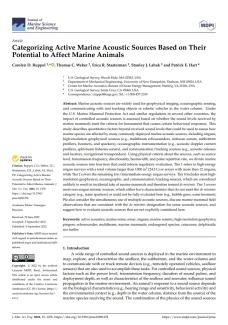To assess the potential sound source impacts on marine species, it is critical to fully understand sound source acoustic characteristics. BOEM has undertaken several studies to measure sound sources in both the laboratory and the field and has also used modeling approaches to better quantify propagation of certain sources.
Sound Source List
The CMA recently compiled basic information about sound source types from activities that BOEM regulates in the Sound Source List document. This is a living document that BOEM will update as new information becomes available. Please contact us at boemacoustics@boem.gov with any suggestions or changes.
The CMA is working to characterize and better understand the following sound sources, which are also included in the Sound Source List.
Seismic Airguns
BOEM uses commercially available and current, state-of-the-art models to calculate airgun arrays source levels and radiated sound fields. These models generate data for BOEM’s detailed impact analyses and have been rigorously tested and calibrated against numerous actual measurements for numerous operational individual airguns and arrays.
High-Resolution Geophysical (HRG) Sources
High-Resolution Geophysical (HRG) sound sources are used at different phases within all of BOEM’s program areas. Use of these sources requires consistent, well-grounded regulation.
Historically, measurements of HRG sound sources have not been well-calibrated. The CMA, working with the U.S. Geological Survey (USGS), has addressed this shortfall with a study measuring HRG sources in a carefully controlled and calibrated lab setting. The Naval Undersea Warfare Center – the nation’s standard for underwater sound source calibration – conducted the initial source characterizations. Once this was completed, the team conducted in situ measurements of the sound fields produced by these HRG sources for various shallow water depths (10, 30, 50–100 m) and sediment types (sand and silt). The study also identified how well commonly available underwater propagation model results compared to the measurements in this study. The CMA study recommended the best approaches to model the predicted sound fields for these systems. The study reports will be available at BOEM’s Environmental Studies HUB.
After completing this HRG study, BOEM worked with USGS and the National Science Foundation to complete a technical analysis of active acoustic sources (including both seismic airguns and HRG). BOEM divides the sources into four tiers based on physical characteristics and the potential to affect marine species:
- Tier 1: Large seismic airgun arrays
- Tier 2: Smaller arrays and single airguns
- Tier 3: HRG sources that may not result in incidental take if certain mitigations are applied
- Tier 4: HRG sources considered to be de minimis, meaning they are unlikely to result in incidental take of marine mammals even without any mitigation
Importantly, the technical analysis also describes several key physical factors that should be used when analyzing any sound source (e.g., beamwidth, duty cycle, radiated power, etc.).
Impact Pile Driving
BOEM has developed a Sound Field Verification (SFV) protocol for documenting sound propagation from wind turbine foundation installation to estimate distances to regulatory thresholds for potential injury and harassment to marine life. This protocol is necessary to verify that the modeled acoustic fields used in BOEM’s analysis are conservative enough to properly estimate the number of acoustic exposures of protected marine species. Recorded measurements will be compared to defined targets to ensure that received levels measured by SFV recorders during installation are equal to or lower than levels modeled at those locations.
Underwater Explosions
BOEM and the Bureau of Safety and Environmental Enforcement (BSEE) have produced a combined underwater acoustic source and propagation model capable of predicting the sound fields produced during the explosive removal of underwater structures. The model is based on acoustic measurements of the sound field produced for multiple explosive weights of standard configurations, for multiple water depths, charge depths (at or below the mudline), and sediment types. This model, called the UnderWater Calculator (UWC-3, version 3), is based on empirical measurements made on numerous such removals.





